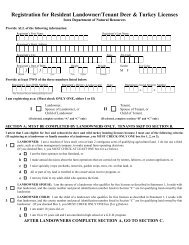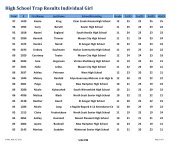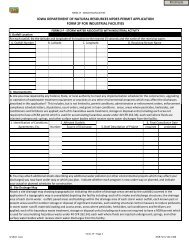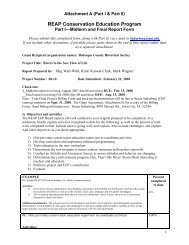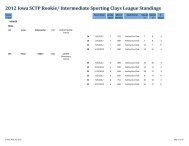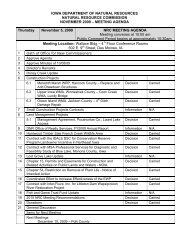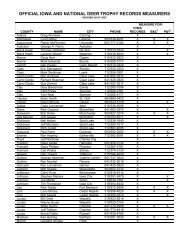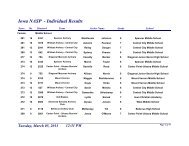What is Chapter 133? - Iowa Department of Natural Resources
What is Chapter 133? - Iowa Department of Natural Resources
What is Chapter 133? - Iowa Department of Natural Resources
You also want an ePaper? Increase the reach of your titles
YUMPU automatically turns print PDFs into web optimized ePapers that Google loves.
<strong>Iowa</strong> Admin<strong>is</strong>trative Code (IAC) <strong>Chapter</strong> 567-<strong>133</strong><br />
Rules for Determining Cleanup Actions and Responsible Parties<br />
Stakeholder Rule Review & Input Meeting – April 30, 2013<br />
Contaminated Sites Section<br />
<strong>Iowa</strong> <strong>Department</strong> <strong>of</strong><br />
<strong>Natural</strong> <strong>Resources</strong>
Purpose <strong>of</strong> Today’s Meeting<br />
Overview - <strong>What</strong> <strong>is</strong> <strong>Chapter</strong> <strong>133</strong> and why rewrite it<br />
Stakeholder Input – Questions, Comments, Identify<br />
<strong>is</strong>sues<br />
Further Analys<strong>is</strong> on Topics<br />
Plan follow-up activities
<strong>What</strong> <strong>is</strong> <strong>Chapter</strong> <strong>133</strong>?<br />
Groundwater cleanup rules for point sources <strong>of</strong> contamination<br />
Offshoot <strong>of</strong> 1987 Groundwater Protection Act<br />
Prescribes universal groundwater cleanup standards:<br />
groundwater “action levels”<br />
Allows alternative cleanup approaches<br />
Prescribes Polluter Pays liability with joint & several prov<strong>is</strong>ion<br />
Directs DNR to identify parties responsible for contamination<br />
Compensation for damages to natural resources (2010 add-on)
Situations Under the Purview <strong>of</strong> <strong>Chapter</strong> <strong>133</strong><br />
(or handled under statutory authority)<br />
General: Contamination not the result <strong>of</strong> a permitted d<strong>is</strong>charge
Situations Under the Purview <strong>of</strong> <strong>Chapter</strong> <strong>133</strong><br />
Waste d<strong>is</strong>posal prior to regulation, e.g., old city dumps
Situations Under the Purview <strong>of</strong> <strong>Chapter</strong> <strong>133</strong><br />
Leaking underground storage tanks not under UST program
Situations Under the Purview <strong>of</strong> <strong>Chapter</strong> <strong>133</strong><br />
Contaminant releases associated with above-ground storage tanks
Situations Under the Purview <strong>of</strong> <strong>Chapter</strong> <strong>133</strong><br />
Fill material from industrial waste, e.g., foundry sand & fly ash
Situations Under the Purview <strong>of</strong> <strong>Chapter</strong> <strong>133</strong><br />
Incidental leaks & spills <strong>of</strong> solvents, e.g., dry cleaners, printers,<br />
platers, maintenance shops, industrial metal degreasing
Situations Under the Purview <strong>of</strong> <strong>Chapter</strong> <strong>133</strong><br />
Former manufactured gas plants
Situations Under the Purview <strong>of</strong> <strong>Chapter</strong> <strong>133</strong><br />
Areas near surfaces painted with lead-based paints
Situations Under the Purview <strong>of</strong> <strong>Chapter</strong> <strong>133</strong><br />
Roadsides with fallout from vehicle em<strong>is</strong>sions
Situations Under the Purview <strong>of</strong> <strong>Chapter</strong> <strong>133</strong><br />
Areas where products have been overused
Situations Under the Purview <strong>of</strong> <strong>Chapter</strong> <strong>133</strong><br />
Areas near railroads and railroad ties (treated lumber)
Situations Under the Purview <strong>of</strong> <strong>Chapter</strong> <strong>133</strong><br />
Businesses handling bulk quantities <strong>of</strong> chemicals, e.g., ag-chem dealers
Who Is Affected by <strong>Chapter</strong> <strong>133</strong>?<br />
Any business that handles chemicals or has handled chemicals,<br />
especially in large quantities<br />
Property owners who conduct Phase 2 Environmental<br />
Assessments and all associated parties, e.g., lenders, realtors,<br />
developers, environmental consultants, attorneys.<br />
Parties who are responsible for (i.e., caused, contributed to, or<br />
exacerbated) otherw<strong>is</strong>e unregulated contamination.<br />
Residents and property owners adjacent to properties on which<br />
contamination has been identified.<br />
Drinking water supplies impacted by point sources <strong>of</strong><br />
contamination
Types <strong>of</strong> Environmental Regulation<br />
Permitted d<strong>is</strong>charge/controlled release/ (not applicable to <strong>133</strong>)<br />
Non-degradation, a.k.a. prevention (cleanup goal <strong>of</strong> current <strong>133</strong>)<br />
Universal cleanup standards (current <strong>133</strong>) :<br />
• Chemical-specific & media-specific<br />
• Applies everywhere, e.g., every drop <strong>of</strong> groundwater, ounce <strong>of</strong><br />
soil, or breath <strong>of</strong> air<br />
R<strong>is</strong>k-based cleanup standards (RBCA) (proposed <strong>133</strong>):<br />
• Cumulative r<strong>is</strong>k from exposure to multiple chemicals in<br />
multiple media (more protective)<br />
• Applies only at the location where exposure to the media<br />
containing the contaminants occurs (less stringent)
Regulation<br />
Contaminated Site Regulation in <strong>Iowa</strong><br />
Scope<br />
Prevention<br />
Component<br />
Cleanup<br />
Approach<br />
Federal<br />
Bas<strong>is</strong><br />
Fed CERCLA Worst hazardous sites in nation No ≈R<strong>is</strong>k-Based Yes<br />
Fed RCRA Management <strong>of</strong> hazardous waste Yes ≈R<strong>is</strong>k-Based Yes<br />
IA <strong>Chapter</strong> 113 Solid waste d<strong>is</strong>posal Yes Universal Yes<br />
IA <strong>Chapter</strong> 131<br />
Hazardous conditions (ER)<br />
especially recent spills<br />
No<br />
Not<br />
Applicable<br />
IA <strong>Chapter</strong> 135 Underground storage tank-related Yes R<strong>is</strong>k-Based Yes<br />
IA <strong>Chapter</strong> 137 Land Recycling Program (VCP) No R<strong>is</strong>k-Based Indirectly<br />
No<br />
IA <strong>Chapter</strong> <strong>133</strong><br />
Ex<strong>is</strong>ting<br />
Groundwater-related contamination<br />
(not from UST)<br />
No Universal +<br />
R<strong>is</strong>k-Based<br />
No
Regulation<br />
Contaminated Site Regulation in <strong>Iowa</strong><br />
Scope<br />
Prevention<br />
Component<br />
Cleanup<br />
Approach<br />
Federal<br />
Bas<strong>is</strong><br />
Fed CERCLA Worst hazardous sites in nation No ≈R<strong>is</strong>k-Based Yes<br />
Fed RCRA Management <strong>of</strong> hazardous waste Yes ≈R<strong>is</strong>k-Based Yes<br />
IA <strong>Chapter</strong> 113 Solid waste d<strong>is</strong>posal Yes Universal Yes<br />
IA <strong>Chapter</strong> 131<br />
Hazardous conditions (ER)<br />
especially recent spills<br />
No<br />
Not<br />
Applicable<br />
IA <strong>Chapter</strong> 135 Underground storage tank-related Yes R<strong>is</strong>k-Based Yes<br />
IA <strong>Chapter</strong> 137 Land Recycling Program (VCP) No R<strong>is</strong>k-Based Indirectly<br />
No<br />
IA <strong>Chapter</strong> <strong>133</strong><br />
Proposed<br />
Groundwater, surface water, soil and<br />
vapor intrusion (not under other program)<br />
No<br />
R<strong>is</strong>k-Based<br />
only<br />
No
Contaminated Sites by Program<br />
UST<br />
Sites Not Yet<br />
Identified<br />
Note: Based on rough estimates
Federal/State Coordination?
Federal/State Coordination? Not in th<strong>is</strong> case.<br />
<strong>Chapter</strong> <strong>133</strong> rules do not implement a federal program.
Statutory Bas<strong>is</strong> for <strong>Chapter</strong> <strong>133</strong><br />
<strong>Iowa</strong> Code 455B, Div<strong>is</strong>ion IV, Part 4: Hazardous Conditions<br />
(1979-1986)<br />
<strong>Iowa</strong> Code 455E.5 (5): 1987 Groundwater Protection Act
Statutory Authority<br />
<strong>Iowa</strong> Code <strong>Chapter</strong> 455B, Div<strong>is</strong>ion IV, Part 4<br />
Hazardous Conditions<br />
455B.381(4) " Hazardous condition" means any situation involving the<br />
actual, imminent, or probable spillage, leakage, or release <strong>of</strong> a<br />
hazardous substance onto the land, into a water <strong>of</strong> the state, or into the<br />
atmosphere, which creates an immediate or potential danger to the<br />
public health or safety or to the environment.<br />
455B.381(5) "Hazardous substance" means any substance or mixture<br />
<strong>of</strong> substances that presents a danger to the public health or safety and<br />
includes but <strong>is</strong> not limited to a substance that <strong>is</strong> toxic, corrosive, or<br />
flammable, or that <strong>is</strong> an irritant or that generates pressure through<br />
decomposition, heat, or other means.
Statutory Authority<br />
<strong>Iowa</strong> Code <strong>Chapter</strong> 455B, Div<strong>is</strong>ion IV, Part 4<br />
Hazardous Conditions<br />
455B.382: The department shall be the agency <strong>of</strong> the state to prevent,<br />
abate, and control the exposure <strong>of</strong> the citizens <strong>of</strong> the state to hazardous<br />
conditions<br />
455B.383(1): The department shall establ<strong>is</strong>h such rules as are<br />
necessary to protect the public from unnecessary exposure to<br />
hazardous substances.
Statutory Authority<br />
<strong>Iowa</strong> Code <strong>Chapter</strong> 455E<br />
Groundwater Protection Act<br />
455E.4 Groundwater Protection Goal:<br />
“The intent <strong>of</strong> the state <strong>is</strong> to prevent contamination <strong>of</strong> groundwater<br />
from point and nonpoint sources <strong>of</strong> contamination to the maximum<br />
extent practical, and if necessary to restore the groundwater to a<br />
potable state, regardless <strong>of</strong> present condition, use, or character<strong>is</strong>tics.”
Statutory Authority<br />
<strong>Iowa</strong> Code <strong>Chapter</strong> 455E<br />
Groundwater Protection Act<br />
455E.5(5) Groundwater Protection Policy:<br />
“Documentation <strong>of</strong> any contaminant which presents a significant r<strong>is</strong>k<br />
to human health, the environment, or the quality <strong>of</strong> life shall result in<br />
either passive or active cleanup. In both cases, the best technology<br />
available or best management practices shall be utilized. The<br />
department shall adopt rules which specify the general guidelines for<br />
determining the cleanup actions necessary to meet the goals <strong>of</strong> the<br />
state and the general procedures for determining the parties<br />
responsible by July 1, 1989.”
Statutory Authority<br />
Summary<br />
Statutes adopted >25 years ago when major contaminated<br />
sites were in the news<br />
Statutes provide broad authority to address potentially<br />
problematic contamination (not limited to groundwater)<br />
Groundwater emphas<strong>is</strong> on prevention<br />
Universal cleanup standards preferred for groundwater, but<br />
r<strong>is</strong>k-based cleanup standards allowed<br />
Problematic contamination vaguely defined by statute,<br />
i.e., any contaminant which poses a significant r<strong>is</strong>k to<br />
human health (Details left to rulemaking)
Current <strong>Chapter</strong> <strong>133</strong><br />
“The goal <strong>of</strong> groundwater cleanup <strong>is</strong> use <strong>of</strong> best available<br />
technology and best management practices as long as it <strong>is</strong><br />
reasonable and practical to remove all contaminants, and<br />
in any event until water contamination remains below the<br />
action level for any contaminant, and the department<br />
determines that the contamination <strong>is</strong> not likely to increase<br />
and no longer presents a significant r<strong>is</strong>k. Where site<br />
conditions and available technology are such that<br />
attainment <strong>of</strong> these goals would be impractical, the<br />
department may establ<strong>is</strong>h an alternative cleanup level or<br />
levels, including such other conditions as will adequately<br />
protect the public health, safety, environment, and quality<br />
<strong>of</strong> life.”
Current <strong>Chapter</strong> <strong>133</strong><br />
“Significant r<strong>is</strong>k” means:<br />
• The presence in groundwater <strong>of</strong> a contaminant in excess<br />
<strong>of</strong> an action level<br />
• The presence <strong>of</strong> a contaminant in the soils, surface water,<br />
or other environment in proximity to groundwater which<br />
may reasonably be expected to contaminate the<br />
groundwater to an action level<br />
“Action level” generally defined to be equal to or more<br />
stringent than drinking-water standards
Current <strong>Chapter</strong> <strong>133</strong><br />
Summary<br />
Addresses only groundwater-related contamination<br />
Addresses groundwater cleanup, not prevention<br />
Preference for universal cleanup standards implied; however,<br />
alternative r<strong>is</strong>k-based cleanup approach allowed<br />
Wide open to interpretation<br />
Problematic contamination (i.e., “significant r<strong>is</strong>k”) <strong>is</strong> specified<br />
broadly to include any contaminant in groundwater or<br />
potentially in groundwater above a “groundwater action level”<br />
• Groundwater action level ≤ drinking-water standards<br />
Net result: problematic contamination now similarly defined<br />
in statute and rule
Implementation <strong>of</strong> Current <strong>Chapter</strong> <strong>133</strong><br />
<strong>Chapter</strong> 137 statewide soil and groundwater standards used as<br />
triggers for further action; usually just more investigation<br />
Most reports <strong>of</strong> contamination come from phase 2 environmental<br />
assessments conducted to facilitate property transfers<br />
• Many not reported due to vague reporting requirements???<br />
• No proactive program to look for contamination<br />
Contaminated Sites staff assess contaminant findings in context <strong>of</strong><br />
site location<br />
• Likely source <strong>of</strong> contaminants<br />
• Magnitude, extent, toxicity & mobility <strong>of</strong> contaminants<br />
• Potential exposure to contaminants, e.g., location <strong>of</strong> DW wells<br />
Most sites minor and remedial actions not required<br />
SUMMARY: informal r<strong>is</strong>k-based approach utilized (accepted)
Reasons to Rewrite <strong>Chapter</strong> <strong>133</strong><br />
The nature <strong>of</strong> contaminated sites concerns has changed from few<br />
large, nasty Superfund sites to many commonplace situations<br />
Problematic contamination <strong>is</strong> commonplace based on current<br />
regulations, creating many undo brownfield concerns<br />
Environmental regulatory concerns have expanded to included<br />
contaminants in soil and vapor intrusion<br />
The 1995 <strong>Iowa</strong> Supreme Court “Blue Chip” dec<strong>is</strong>ion struck down<br />
joint and several liability<br />
Enforcement <strong>of</strong> universal cleanup standards has proven<br />
impractical; alternative (r<strong>is</strong>k-based) cleanup approaches have<br />
taken their place , e.g., more recent <strong>Chapter</strong>s 135 and 137<br />
Need to formally adopt an approach to ensure cons<strong>is</strong>tency and<br />
provide a clear pathway for the regulated public
Potential Benefits from Rewriting <strong>Chapter</strong> <strong>133</strong><br />
More cons<strong>is</strong>tency in addressing contaminated sites<br />
No need to default to other, more stringent standards<br />
Fewer uncertainties as to what <strong>is</strong> problematic contamination<br />
Fewer brownfield concerns, such as:<br />
• Difficulty in transferring property<br />
• Devalued, underutilized, and abandoned properties<br />
• Added costs for redevelopment<br />
• Suburban sprawl
Goals <strong>of</strong> Rewriting <strong>Chapter</strong> <strong>133</strong><br />
Define problematic contamination to ensure a high degree <strong>of</strong><br />
protection to human health and the environment without<br />
being unduly over-protective
Universe <strong>of</strong> Sites<br />
per <strong>Chapter</strong> 137<br />
Universe <strong>of</strong> Contaminated<br />
Sites Current <strong>Chapter</strong> <strong>133</strong><br />
“Real” Problem Sites<br />
Universe <strong>of</strong> Contaminated<br />
Sites Proposed <strong>Chapter</strong> <strong>133</strong>
Goals <strong>of</strong> Rewriting <strong>Chapter</strong> <strong>133</strong><br />
Define problematic contamination to ensure a high degree <strong>of</strong><br />
protection to human health and the environment without<br />
being unduly overly protective<br />
Specify objective criteria for addressing problematic<br />
contamination (to the extent reasonable to do so)<br />
Attempt to avoid onerous burdens <strong>of</strong> pro<strong>of</strong> respecting the<br />
apparent non-ex<strong>is</strong>tence <strong>of</strong> problematic contamination<br />
VS.
Stakeholder Input<br />
Name<br />
Name <strong>of</strong> organization you are representing<br />
Does <strong>Chapter</strong> <strong>133</strong> impact you or your organization?<br />
Do you agree with the proposal to rewrite <strong>Chapter</strong> <strong>133</strong>?<br />
• Yes<br />
• No (why?)<br />
• Unsure (why?)<br />
Major concerns with the proposed rewrite <strong>of</strong> <strong>Chapter</strong> <strong>133</strong>



